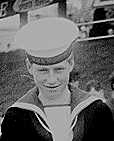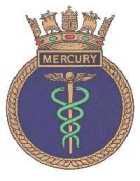 |
I joined HMS Mercury in February 1968 to begin my Comms
training in earnest and if my memory serves me right I think we were billeted in Pasco Block under the watchful eye of CRS Collinson.
Life in Mercury was totally different to that experienced at Ganges, what with Duty Weekends and Watch Duty Party jobs as well as all the training.
The other downside to being at Mercury was it's location, stuck in the middle of the
back and beyond, miles from anywhere exciting.
Anyway, after 6 months hard slog and all exams passed, I emerged
as a Radio Operator 3rd Class (G) specialist, in other words a 'SPARKER'.
Now I was ready for a draft to sea and after two weeks leave I was off to the
Far East to join my first ship, HMS Intrepid. |
|
|
|
A BRIEF HISTORY OF H.M.S. MERCURY |
The school was commissioned as HMS Mercury on 16th August 1941, under the command of a new CSS, Captain Gerald Warner. The first contingent consisted of about 300 ratings, accommodated in a row of tents, with their dining room in what later became the wardroom in Leydene House.
It was a wet summer, and the tents were not very comfortable, but by winter a row of Nissen huts had been erected, housing 24 ratings in each initially, later reduced to 14. Conditions were pretty appalling, particularly in the early winters; this did, however, make the trainees keen to get to sea !
Many more temporary buildings sprang up, one of the most notable being the huge Nissen-type cinema, with a sloping floor on which many ship's company dances were held, which was built in 1943 and was to survive for exactly half a century.
After the war, it was decided that the School should if possible remain at Leydene, as it would probably be cheaper to buy the place rather than to restore it to its pre-war condition and return to the owner. Negotiations with Lady Peel were started, but in 1949 she died, the family did not wish to take it on again, and so Leydene House and about 160 acres were bought by the Crown for £60,000. The rest of the estate was sold off, much of it to tenant farmers.
The number to be accommodated varied but occasionally was not far short of two thousand, though between ten and twelve hundred was more usual, falling to a few hundred when there were cut backs in the Navy or recruiting difficulties. The temporary buildings had to be replaced, and modern amenities provided, so a long period of rebuilding and expansion begain. A modern training block was built, new Dining halls and a Naafi were also built as well a crescent of houses. Later, in the 1970's, with the closure of the Wren's quarters at Soberton Towers a new programme of building work began.
Sadly, HMS Mercury
|

HMS MERCURY PHOTO PAGE
TO BE CONTINUED IN THE NEAR FUTURE
LAST UPDATED - JUNE 2002
|
|





